Menus
- Long-term test over 6,000 km from the chef’s custom to the 1811 cm3
- Discovery
- In the saddle
- Contact
- In the city
- On the highway
- On departmental
- On track
- Braking
- Comfort
- Consumption
- Convenient
- Conclusion
Long-term test over 6,000 km from the chef’s custom to the 1811 cm3
Mythical is the adjective that best fits the brand Indian and not just for Burt Munro’s film the world fastest Indian. The idea of reviving this more than a century old brand was in itself a stroke of genius and going back to the very sources of its history with these big customs was another.. And in terms of history, Indian is proud to be the first American brand, launched in 1901, two years before its main competitor. Polaris has added its mastery of technique and mechanics to successfully revive the brand and the Chieftain model, which in 2014 is undoubtedly the most emblematic or in any case the most touring of models before the arrival of the roadmaster. And to try it out, what better than a long-term test on the brand’s lands, with 6,000 kilometers in the American West. Immediate boarding…
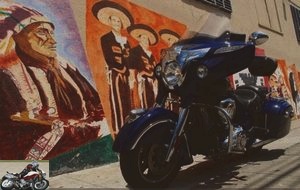
Discovery
From a distance, a non-connoisseur could almost confuse the Chieftain with another famous American brand. Up close, however, there is no possible confusion as Indian has affixed his seal to each of the parts of the motorcycle. From the front mudguard which proudly displays an Indian (and also serves as a parking light when illuminated at night) to the speedometer, front optics, mirrors, saddle, frame, fluid reservoir brake, suitcase locks or the motor which displays the Indian head sculpted in metal through the tank which also displays an Indian head but painted this time, there is no room for doubt. We counted no less than 22 !

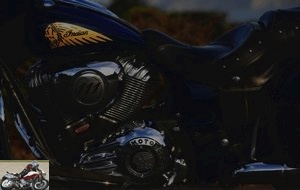
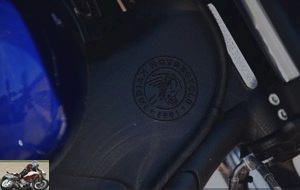
And this is perhaps what makes all the people who approach it ask us: what year is it a model? And from there, the questions are endless. Few motorcycles generate such a flow of questions and questions, but also photos. Because many of these passers-by took out their cameras to take a picture of her. Of course, we are in the United States and the brand awakens many memories from its history. But still…
But let’s come back to the model with its large front face and its electrically height-adjustable screen, for effective protection. The large rider saddle offers space for the most important riders. The thin passenger seat and the pilot seat are fitted with chrome studs.
At the front there is a large central optic framed by two additional side headlights and long tapered indicators.
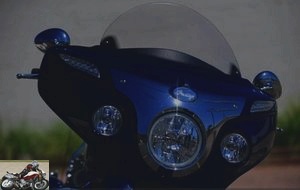
The front fender is mainly characterized by its long skirt which encompasses and hides more than half of the wheel. And the 2015 vintage version further refines the overall lines of the machine.
Finally, the pilot benefits from wide footboards while the passenger has simple footrests.
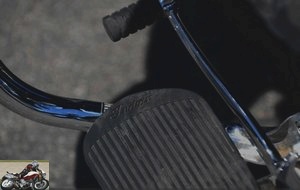
But what we see the most is the enormous 111ci VTwin Thunder Stroke or 1811 cm3 air-cooled magnified by the huge curved cylinder heads, very close to the model that powered the Chiefs from 1940 to 1953.
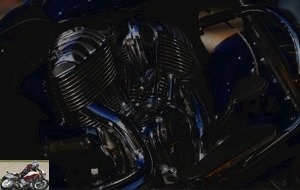
Finally, we appreciate the absence of an ignition key with the transponder, which allows you to turn on the machine only if you are less than a meter from it … but also to block the closing of the cases remotely. . The only use of the supplied key is the steering lock located on the front fork on the right..
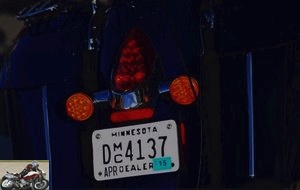
In the saddle
With a saddle at only 660mm, the 1.70 rider puts his feet perfectly flat on the ground, even the 1.60m rider. And it is quite exceptional to underline it because it is rare that the pilot has the feet on the ground, including on the majority of the customs except certain rare models with a saddle under the 700mm. The hands fall naturally on the rather wide handlebars with its 1022 mm, offering an important lever arm, closer to a trail almost than to a usual custom. The feet are placed on the wide side plates and we find the huge rear brake pedal almost horizontal forward as on many customs. On the left, the selector is traditional on the other hand and is not double.

Under the eyes, we then find a real dashboard with the speedometer and the analog tachometer which frame a red digital display and the on-board computer for the gear engaged, the totalizer, the partial double trip, consumption, average and instantaneous consumption, clock, battery voltage, tire pressure, battery voltage, number of hours of engine operation, oil dipstick as well as volume and channel for the radio. Note also the cigarette lighter socket, which is very practical for recharging a laptop or simply powering a GPS..
The commodos are standard for Japanese modules, except on the left with the radio and electric bubble adjustment buttons and on the right with the cruise control. The trigger usually reserved for the lighthouse call allows you to switch the menus of the on-board computer.
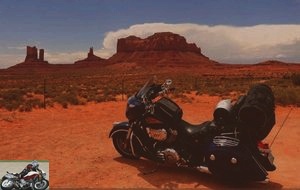
The radio has 100 watts of power … perfect in the US for those who don’t wear a helmet, but a bit tight to be audible on the highway when you wear a good helmet..
The mirrors are easily adjusted and provide excellent rear vision, including with the passenger.
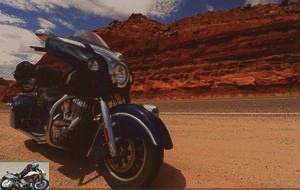
Contact
The twin engine snorts instantly in a particularly rewarding low and hoarse sound. The first engages with a very custom clonk and the other reports engage firmly in stride. Note that the Indian likes to accelerate to shift gears with ease, compared to some models where you can almost go up all gears in stride. The first is long but we like to spend the second or even the third to wind gently. Either way, the Indian appreciates all reports, including almost to boot. And yes, it is possible to start in third and even in fourth! Certainly by playing the clutch a little, but we have rarely seen a motorcycle accept without even stalling being manhandled in this way. Convenient for lazy people who stop at a traffic light in second or third. They don’t even have to go back first to start green!

In the city
With its feet firmly on the ground and its wide leverage, the city is doing well in the Indian style. Its ability to start in any gear and also roll up into virtually any gear including the last one makes it very pleasant around town. It is all the more extraordinary, that the first is pushed up to 65 km / h (40 mph) and that, on the contrary, the Chieftain even accepts to drive at 30 km / h in the sixth and last gear! Who says better ? Admittedly, at 30 km / h in 6th gear, it is between 800 and 900 rpm and that knocks, but it is possible, even if it accepts more easily to wind gently above 1,500tr / min. It even goes very well with the interfile exercise. In fact, it is the Americans who do not appreciate the interface more than the motorbike..
It finds its point of equilibrium from the first meters and suddenly, we forget its weight and its still 369 kilos … dry! Maneuvers when stationary, sitting on the machine, are easily done both forwards and backwards to park it (if an engineer had thought of reverse gear, it would in fact be useless). It just takes a large leg to launch the sidestand from a standstill (and a large one to retract it as well). If I had known, I would have eaten more soup.
Starts depend on the mood of the pilot, who can choose to wind up quietly or on the contrary to wring out the right grip to let the big heart dynamically propel the Chieftain towards the next fire..
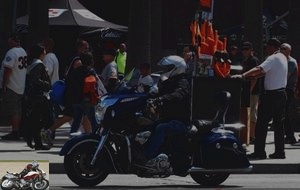
There are still U-turns in town. All is well if the street is wide. But in the alleys, the maneuver takes a little time, because of the rather large turning radius. It is an excellent exercise, moreover, which is appreciated over the weeks when we manage to do it more and more easily..
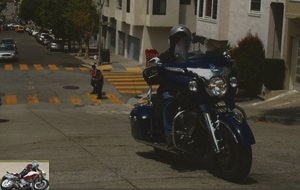
On the highway
The Indian launches dynamic on the highway, easily reaching 130 km / h at just 3,000 rpm, far from the red zone at 6,000 rpm. A blow of the right handle and one reaches easily and with force the 150 km / h to then regularly gain the kilometer hours up to 180 km / h. And you can still scratch a few kilometers hours afterwards if you are well started. The bike is perfectly in line and stable, even loaded in duo and with luggage. At this speed, the protection offered by the bubble is simply excellent. Above all, it does not generate any infrasound in the helmet, whatever its height of adjustment. In the low position, there is just the sound of the wind in the helmet which completely disappears at half height. There is therefore still room even for large sizes. Better, this protection is as effective for the passenger as for the pilot who then appreciate the silence provided by the bubble.
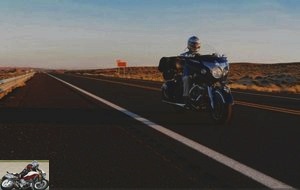
On departmental
At ease in the city as on the highway, the Indian is just as comfortable on small roads, it rolls up on the last report without difficulty. When the departmental roads become small mountain roads, it is better to go back down in fourth … Knowing that it could even be satisfied with the first three reports, with a second that pushes without worry up to 95 km / h and a third up to 130 km / h (80 mph). But what are the other speeds for? Can be simply rolled up quietly without feeling the slightest vibration. And when the little mountain road turns into a tight yaw, the ride becomes a bit sportier, as it easily takes its rider with a little tendency to widen in curves. However, its ground clearance is simply impressive with its 142 mm and you really have to drive really very hard to start making it touch or scrape in a turn, when the vast majority of customs have already made the song of metal heard. . When the vast majority of customs rub effortlessly in roundabouts, nothing like it here.
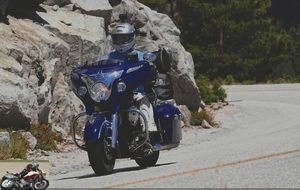
Once again, you can wind quietly or on the contrary take advantage of the torque available from 2,000 rpm and revealing all its big heart at 3,000 rpm. The sensations are there for the greatest pleasure of the pilot and the passenger who must then hang on well..
On track
There are many small roads in American parks that offer tracks rather than well-paved roads, and the sides are generally quite gravely. The Chieftain is doing it with honors, thanks to its low center of gravity and the possibility of recovering the foot from a possible slip..
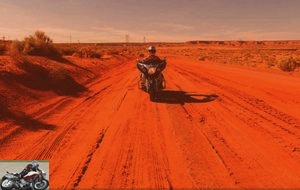
Braking
The front brake brakes … respectfully without overdoing it despite the double 300mm disc and dual-piston calipers. It offers a very good feeling but struggles to brake on its own the 369 kilos launched well of the machine. Comparatively, it is the rear brake with yet its simple 300 mm disc that is particularly powerful, even without pressing hard. And he turns out to be enough to stop the Indian. The two combined offer all the power necessary to effectively stop the Indian even well started. Very uninterusive ABS is a plus.

Comfort
The 119mm telescopic fork and the 94mm single rear shock with mechanical preload provide excellent comfort while smoothing out road imperfections particularly well. The whole thing offers flexible comfort, but not too much.
The saddle of the Indian offers a good and wide comfortable seat. But the first week of driving after 1,500 km of roads, we appreciated a break after 160 km. But at the end of the second week and 3,000 km, we could do 250 km. The passenger is a little worse off than the pilot on the other hand, even with the presence of a sissi bar. But in the end, we can go on the road with it. We did 6000 km in 3 weeks together and without suffering. Be careful, however, to the heat given off by the engine and the exhaust on the right side as soon as the outside temperature exceeds 25 ° C … The right calf may suffer in the long run and the rain pants did not resist it..
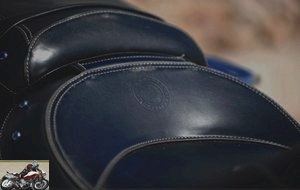
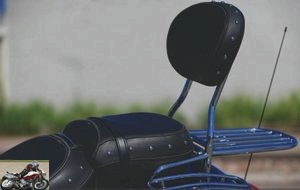
Consumption
Depending on how well the 20.8-liter tank is filled, the Indian has a range of around 400 kilometers. The first quarter of the gauge is thus reached at 120 km, half at 200 km, the third quarter at 290 km. And the reserve warning light then comes on at around 340 km. Note that in the US, it consumes 91 octane gasoline (the highest in fact, since the stations offer 84 and 89 otherwise and nothing above 91).
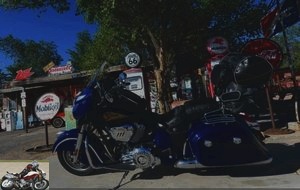
Convenient
The two side cases offer a good capacity with their respective 32 liters, ideal for a long weekend. But for several weeks on the road, it will absolutely be necessary to add a rear rack. The passenger will also appreciate a sissi-bar. It is also possible to mount metal luggage racks on the cases themselves. It is not essential but practical despite everything and all the more so as it integrates well with the line of the machine..
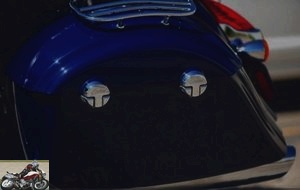
Conclusion
Well-bred, the Chieftain sports all the advancements of a modern machine with a retro look for a smoother style and ride, giving way to torque before sheer power. It gives you a driving peace, not without sensations with this big heart which propels strong from the lowest revs and with a real availability which make it a treat as well in the city as on the motorway. There is space on board and with a sissi-bar accompanied by additional support, we can even consider leaving for several weeks with the lady and this, in a comfortable way. Only its price of 26.199 euros can make you hesitate to take the plunge or start looking directly towards the more GT version with the Roadmaster.
Strong points
- engine and torque -> sensations
- comfort
- consumption
- space on board
- overall finish
Weak points
- Engine heat released on the right side
The Indian Chieftain technical sheet
Related articles
-
Indian Chieftain Limited Trial
The bagger is updated with aesthetic and mechanical evolutions V2, 1811 cm3, 84 hp at 5000 rpm, 150 Nm at 2100 rpm, 364 kilos dry, from € 28,850 With the…
-
2,000 km test of the new Grand Tourisme cruiser There are the traditional customs and then the long-distance motorcycles that promise to take you far as…
-
V2, 1133 cm3, 94 hp, 97 Nm at 5,600 rpm, 245 kilos dry, from € 13,990 A minimalist and stylish machine The air of nothing, this is an important machine…
-
Indian FTR 1200 S Race Replica test
At the crossroads of genres V-Twin of 1,203 cm3, 123 hp and 120 Nm, 222 kg, 17,290 euros In November 2018, our colleague Alan Cathcart tried exclusively…
-
Indian 1200 FTR Rally motorcycle test
Bite V-Twin, 1203 cm3, 120 hp, 120 Nm at 6,000 rpm, 235 kg TPF, 14,990 euros … daily test The word scrambler warms up lots of images, broadcast, told,…
-
Born on the earth, built for the road V-Twin of 1,203 cm3, 120 hp and 115 Nm, 221 kg dry, Sachs suspension, Brembo brakes, from 14,690 euros It had to…
-
One-month trial of the large three-wheel pendulum By rushing into the legislative loophole allowing driving a three-wheeler with a car license, Piaggio…
-
Small 125 but tasty Do we still have to present Kymco? Specialist in small-displacement scooters, the Taiwanese manufacturer has recently made a…
-
The legacy motorcycle of Tron and Akira Is it characteristic of a great manufacturer to dare to even go beyond innovating? In any case, Honda succeeded…
-
Honda CBF 1000 ABS motorcycle test
The Honda CBF 1000 is the big sister of the CBF 600, which appeared in 2006. Apart from a slightly larger size, the two models are aesthetically very…